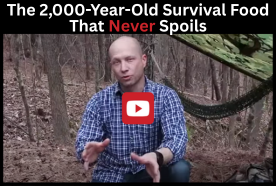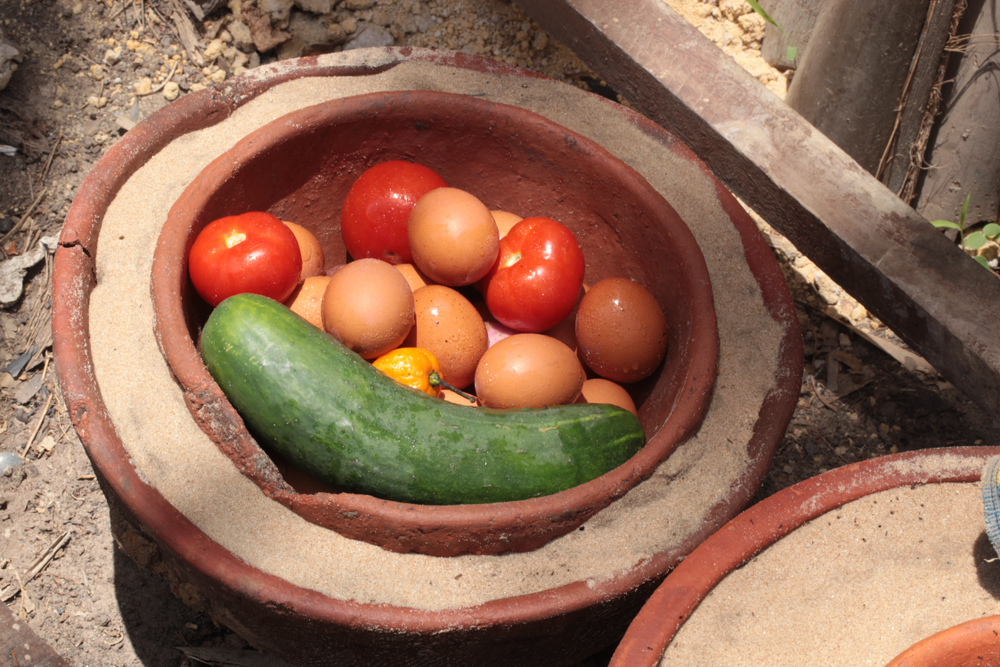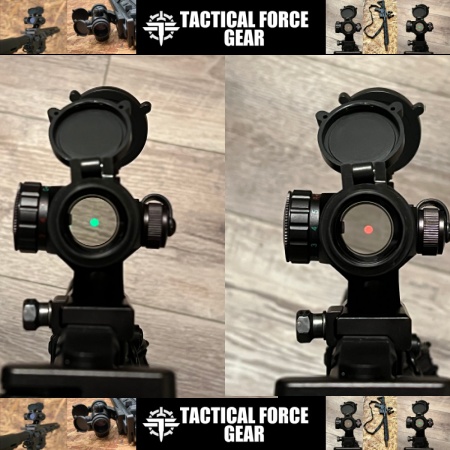When the power grid goes down or you’re living off the land, keeping food fresh climbs to the top of the list. Modern refrigerators need electricity you may not have. An ancient answer steps in. The Zeer pot, a clay pot refrigerator, uses clay, sand, and water to keep perishables cool. Egyptians used devices like this as early as 2500 B.C.
What Is a Zeer Pot and How Does It Work?
A Zeer pot, also called a pot-in-pot refrigerator, is a non-electric cooler that runs on passive evaporative cooling. Two unglazed clay pots nest together with a layer of wet sand between them. Water moves through the porous outer pot and evaporates. Evaporation absorbs heat and pulls it away from the inner chamber, which cools the food inside, the same way sweat cools skin. When water evaporates, it absorbs heat energy and drops the temperature. Dry, moving air accelerates evaporation, so shade and airflow increase cooling.
To build the basic form, place a smaller unglazed clay pot inside a larger one and pack the gap with sand. Saturate the sand with water. The inner pot becomes your cool chamber. The outer pot “sweats,” and that moisture evaporates into the air, carrying heat away from the inner pot. The result is an open-cycle refrigerator powered by nature. Water serves as the refrigerant. Evaporation, not electricity, produces the cooling. A shaded, well-ventilated placement prevents solar heating and gives the breeze room to help. In hot, arid regions, this setup keeps fruits, vegetables, and drinks far cooler than outside air. Families in parts of Africa and Asia still rely on it where electricity is scarce, which stretches the life of produce well beyond ambient conditions.
How to Build a Zeer Pot Refrigerator (Step-by-Step)
Building a clay pot cooler is straightforward. You need two unglazed terracotta pots, one larger and one smaller, clean sand, water, and a cloth. Duct tape or clay can plug drain holes. A lid or plate that fits the small pot helps.
-
Gather Two Clay Pots
Choose a large terracotta pot and a smaller one that leaves about 2–3 inches of space all around between them. Use unglazed, porous pots so the outer wall can pass moisture and evaporate it. Plastic or glazed pots block evaporation and halt cooling. -
Prepare the Pots
Seal any drainage holes with tape or clay so sand and water stay in place. Set the larger pot on a stable surface. -
Add a Sand Base
Pour a level layer of clean sand into the bottom of the big pot. Aim for a thickness that positions the small pot’s rim roughly level with, or slightly above, the rim of the outer pot when nested. This helps keep sand and water out of the inner chamber. -
Insert the Inner Pot
Center the small pot inside the larger one, resting on the sand base. Keep an even gap around the sides. -
Fill the Gap with Sand
While holding the inner pot steady, add sand into the annulus a little at a time, working evenly around the circle. Pack the sand firmly. Firm packing improves heat transfer. If sand falls into the inner pot, remove it before loading food. -
Add Water to the Sand
Moisten the sand slowly and evenly. Move your container around the ring so water distributes without washing sand out of place. Stop when all sand is saturated and darkened, with no pooled water above the surface. If the sand settles, top up with more sand and water. -
Cover and Cool
Load food into the inner pot. Cover with a fitted lid or plate and drape a damp cloth across the opening for better chill retention. -
Position the Cooler
Move the cooler to deep shade with free airflow. A covered porch or the north side of a building works well. Elevate the pot on bricks or a stand so air can flow beneath it, which adds a bit of performance. -
Maintain Moisture
Watch for a cool, evenly damp outer wall over the next hours. If the bottom half stays dry, add more water to the sand. Re-wet at least twice daily, morning and evening, and more often during extreme heat.
With these steps, you now have a working pot-in-pot refrigerator. Communities have built them for only a few dollars in materials, all sourced from basic hardware and garden suppliers.
Best Climates for Zeer Pot Cooling
Hot, dry climates fit this method best. The drier the air, the more evaporation, and the greater the cooling. In arid or semi-arid regions, a well-managed Zeer pot often reaches 20–30°F below ambient temperature. Humid air slows evaporation and reduces the temperature drop. Airflow adds power. A steady breeze can push the interior toward about 40°F in ideal dry conditions. Calm air leads to a smaller drop, so a small battery or solar fan can mimic a breeze on still days.
Consider a mid-humidity test in Texas. With outside air in the low 90s°F and humidity near 50 percent, the inner pot settled in the mid-70s°F, for a drop of about 15°F. In very dry air the same build can slide into the 50s or 60s°F. Deserts and dry-summer zones such as Arizona, New Mexico, and Nevada deliver the strongest results. Gulf Coast and Southeast climates still see a useful drop, especially in shade with any breeze. Shade remains vital everywhere, since direct sun reheats the pot and works against cooling. The winning combination is hot, dry, shaded, and airy.
What Foods Can It Preserve?
A clay pot cooler shines with produce and short-term dairy. Fruits and vegetables gain crispness and time. Tomatoes, peppers, eggplant, greens, and okra fare far better in the cool, humid chamber than on a hot counter. Field studies show shelf life can jump from days to weeks in some cases. The air inside stays moist, so vegetables do not wilt the way they often do in a dry refrigerator stream. Carrots keep snap. Greens keep lift. Fruits such as apples, citrus, melons, and berries also benefit. Bottled drinks cool to a pleasant temperature for field work.
Dairy benefits in short runs. A small jar of milk, a wedge of cheese, or butter stays cooler and safer than kitchen air. Food safety guidelines place multi-day milk storage at about 40°F, a mark only very dry, breezy conditions approach. Expect the 50s or 60s°F more often. Use this as a bridge to tomorrow, then consume.
Raw meat and fish require true refrigeration around 35–40°F for safe storage. Evaporative cooling sits above that range and serves best as a staging area before cooking. For long keeping, lean on drying, smoking, salting, or canning. Medicines such as insulin also follow strict temperature rules, so plan secure cold for those items.
Zeer Pot vs. Modern Refrigeration
A kitchen refrigerator holds 35–40°F. A Zeer pot tracks the wet-bulb temperature of the day, which depends on humidity and airflow. In very dry air it can approach the 40s°F, while many regions will see 50–60°F. That level turns a blistering afternoon into springlike storage for produce. The refrigerator still rules for meat, leftovers, sensitive dairy, and medicine.
Humidity favors the clay cooler. The chamber stays moist, so greens and roots keep texture and color instead of drying out. Many homesteaders notice equal or better quality for vegetables stored in a well-managed Zeer pot than in a dry fridge compartment.
Shelf life tells the same story. A fridge stretches everything through cold alone. A Zeer pot stretches produce through moderate cool and high humidity. Tropical fruits that fail in two days at 90°F can pass a week inside the pot. Milk that lasts a week in a fridge gains only a day or two in clay.
Maintenance differs. A fridge draws electricity nonstop. A Zeer pot draws water and a few minutes of care. In hot, dry weather, a single pot can evaporate a couple of gallons per day. Gray water or rainwater works well because the inner chamber stays sealed from the evaporative layer. A lined or glazed inner pot also allows use of non-potable water in the sand gap, even saltwater, with no contact to stored food.
Capacity also differs. A Zeer pot holds a modest load and thrives as a set of several small units rather than one giant tub, which improves surface area for evaporation. In return you get silence, no heat dump into the room, and continuous operation as long as you keep the sand wet.
In short, the refrigerator delivers deep cold across the board. The Zeer pot delivers excellent produce care and useful cooling during outages. Treat it as a partner, not a rival. Let clay carry fruits and vegetables, and reserve hard-cold space for high-risk items.
Using Clay Pot Cooling Off-Grid
For U.S. preppers and homesteaders, a Zeer pot acts like low-cost insurance. A hurricane knocks out power in July. The porch in deep shade becomes your cooling station. Tomatoes, squash, greens, and berries hold while you can, dry, ferment, or trade. Medications that benefit from cooler air ride safer inside clay than on a hot counter. Preparedness writers list the Zeer pot as a smart grid-down backup for exactly this gap.
Off-grid households can fold clay cooling into daily routines. Let the pot handle produce outdoors and free up space in a propane or solar fridge. Over time that choice saves fuel and money. Many homesteaders run several pots at once. One for vegetables, one for fruit, and one for drinking water or cultured dairy. Clay carries no electronics, so maintenance means simple cleaning and steady watering. Scrub mineral scale off the outer wall once in a while to keep pores open.
Create a watering rhythm. Morning and evening serve most climates. Add a midday check during heat spikes. A linen or burlap cover over the lid and partway down the sides slows evaporation at the top and reduces refill frequency. A mesh screen keeps dust and insects out. Pick a spot with a natural cross-breeze, and place the pot where kids and animals will not tip it. A simple wood cradle adds stability.
Practice before you depend on it. Try the pot across seasons and contents. Log temperatures. Learn which corner catches the prevailing wind. An Arizona homestead will see different numbers than a Florida backyard. A simple probe thermometer in the inner pot tells the truth about your microclimate. Notes like “August holds near 60°F when watered twice a day” guide real decisions later.
A Zeer pot is one piece of a larger plan. It brings ancient know-how to modern resilience, without fuel or wires. It also delivers a certain satisfaction. You build it with your hands, feed it a little water, and watch it earn its keep.

Other Passive Cooling Methods for Food Storage
Root Cellars and Cool Pantries
Earth carries a steady cool. An underground or earth-bermed pantry can hold between about 38°F and 65°F through the year at depths of 5–10 feet. That range slows spoilage of roots, apples, grains, and home-canned goods for long stretches. Ventilation keeps humidity in check while the ground moderates heat.
Spring Houses or Shaded Spring Boxes
Cold, moving water chills food. A spring house or shaded box over a creek keeps milk, butter, and meat in the mid-50s°F range. Place jars or sealed containers in the water inside a shaded structure and secure them against drift. The water’s stable temperature does the work.
Zeer Pot Cousins, the Coolgardie Safe and Evaporative Cabinets
In dry regions, a mesh cupboard wrapped in wet hessian or towels and set in a draft acts like a large evaporative cabinet. Air passing across the wet fabric cools the interior and adds shelf space. The principle matches the clay pot. Low humidity favors performance.
These methods combine well. Use earth, water, evaporation, and shade together. A Zeer pot earns a place in any off-grid plan. Root cellars, spring boxes, and evaporative cabinets add redundancy. With a little ingenuity, you can keep food cool and safe when modern systems fall silent, proof that old tech still serves when you need it most.






Read the full article here



